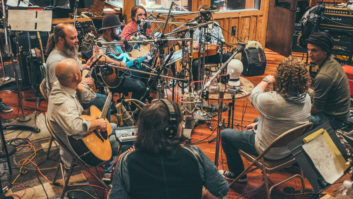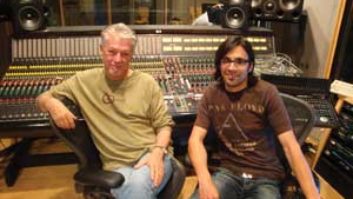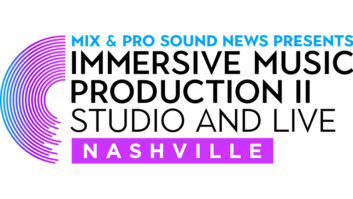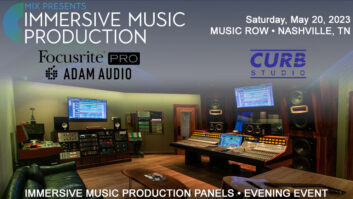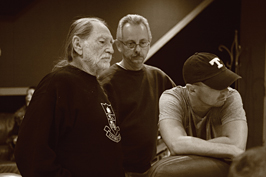
Charged with producing vocals on the King of Broken Hearts himself, Buddy Cannon figured it was best to be smiling and positive. After all, George Jones knows how to sing a country song and doesn’t need a lot of help in the matter.
Moment of Forever” />
Willie Nelson with Buddy Cannon and Kenny Chesney (in baseball cap) during work on Nelson’s album Moment of Forever
Photo: Courtesy Sony/BMG
“Man, George was on his ‘A’ game, and we were recording an album on him,” says Cannon, who back then — in 1993 — was a young buck producer with a couple of country hits under his belt. “And he made me feel intimidated as hell. I don’t think he tried to, but just his presence was intimidating. One time, he got finished with a vocal, and I said, ‘That was pretty good.’ He said, ‘Pretty good — hell! Let’s do it again, then.’”
Cannon — who has gone on to produce smash country hits for Kenny Chesney, Reba McEntire, Chely Wright and Sara Evans — smiles when he recounts the story of Jones’ profane perfectionism. He smiles at lots of other things, too. Knowing he’s being interviewed for an audio magazine, Cannon is well-pleased to announce his love of digital reverb, his lack of technical prowess and his insistence that it’s more important to have a room that’s comfortable than it is to have a room that’s sonically superior.
“I don’t know nothing about this stuff,” he says, gesturing to a digital board at Blackbird Studios. “I’m a technical dummy. I guess I wish I knew, but I don’t want to make the time to learn. I figure, ‘Why should I do that when I have an engineer who already knows how?’ So I choose rooms by comfort level. I like a room that’s big enough for the whole band to come back in and hear the playback.”
So when Cannon and Chesney set about producing a Willie Nelson album last year, it was Cannon’s choice to use Sound Kitchen, one of the Southeast’s largest recording studios. Sound Kitchen has a studio called the Big Boy room, with a custom API Legacy board, 3,000 square feet of tracking space and an ample control room. That’s where Cannon was recording Nelson.
“Yeah, but it wasn’t big enough,” Cannon says, smiling again. “You ever seen all the people that Willie attracts? Plus, songwriting buddies of Willie’s kept dropping by, and at one point there were so many people in the control room that the band couldn’t get in there.”
The Nelson album, called Moment of Forever, came out this past July. It finds Nelson singing songs from sources as disparate as Kris Kristofferson, Dave Matthews, Big Kenny (from Big & Rich) and a bluegrass-leaning Shakespeare-type named Paul Craft. Because of Chesney’s relative youth, many listeners and reviewers assumed that the country superstar brought Matthews’ “Gravedigger” to Nelson. In fact, it was Cannon, who heard Matthews sing the song at an Emmylou Harris tribute concert one evening.
“I’d heard of Dave Matthews, but I’d never seen him or heard a song of his,” Cannon says. “When he sang it, I was frozen. I thought, ‘That could be cut in our format.’ That was three months before we started the Willie record, and when I showed it to Willie he jumped all over it.”
That’s another thing about Cannon: He believes song-finding is more important than microphones or preamps in the grand scheme of things. He began working in Nashville as a bass player in the 1970s, and Mel Tillis saw fit to hire him in his band and employ him at Tillis’ publishing company. After shifting to an A&R position at Mercury Records, Cannon became interested in producing.
“What drove me to producing was the creative side,” he says. “I hated picking up records and looking at the liner notes and seeing 10 songs from one publishing company, when I knew there were better songs available. I always wanted to make a better record by doing better songs. I have never been any better at the skill of producing than anybody else, but I thought my song sense was better. It’s like a challenge: ‘I can beat that.’”
Cannon’s first major shot at producing came on an artist named Sammy Kershaw, who initially detested a song that Cannon liked called “Cadillac Style.”
“All we had was a work tape, done on a jam box, as a guitar vocal,” Cannon says. “It was really rough, but it sounded like an obvious hit to me. Kershaw said, ‘You’re crazy, I ain’t cutting that. That’s terrible.’”
But at session’s end, there were about 15 minutes left in the musicians’ contracted schedule. “Cadillac Style” was a simply structured song, and Cannon asked the band to give it a try. “As soon as we cut it, Sammy fell in love with it. And that became his, and my, first Number One hit.”
Cannon’s old-school country pedigree did not hinder him from accepting and embracing Nashville’s move away from analog tape. “Man, I thought the best thing I ever heard was that crisp, digital reverb; that little Lexicon box,” he says. “I loved it. And I was one of the first guys to get on those 32-track digital Mitsubishi machines. I guess most people don’t like to change, but there’s no sense in letting any of that bother you.”
Cannon’s most successful regular client is Chesney, who has become the top touring act in contemporary country music and a regular pick for Entertainer of the Year at country awards shows. Cannon co-produces Chesney’s albums with the artist, and the two men are currently working on a new album at the Sound Emporium’s Studio A, with engineer Tony Castle manning the Neve VRP console. The project, which has been going on in fits and starts (when stadium shows collide with available studio time, the stadium shows tend to win) for two years, was begun at the now-shuttered Emerald Sound Studios.
“You couldn’t ask for a better-hearted guy to work with than Kenny,” Cannon says. “And he’s talented, man. In the studio when we’re making a record, he is the creative force. The musicians have absolute respect for him, and he drives it when we’re recording. My job is to let Kenny be Kenny. If I thought he was going wrong somewhere, I would speak up. But he doesn’t do that.”
While plenty of folks on Music Row bemoan MP3s and ear buds and all of that, Cannon keeps thinking it might be best to just go ahead and start monitoring in MP3 and listening through the ear buds.
“We spend thousands of dollars mixing records, but we don’t even know what it sounds like to 90 percent of the people listening,” he says. “Go with the state of the listener.”
And though he’s fussier about microphones than about most other gear, Cannon doesn’t care to be on a first-name basis with those mics. He sets one up in front of the singer, listens for awhile and then makes adjustments based on what sounds good.
“I will make the decision on what mic we use, but I don’t have any idea what they are,” he says. “Someone asked me about what mic we were using on Kenny, and I said, ‘It was either that round one or that square one. Call Tony Castle and ask him if you want to know for sure.’”
Send Nashville news to Peter Cooper:
skyline [email protected].
